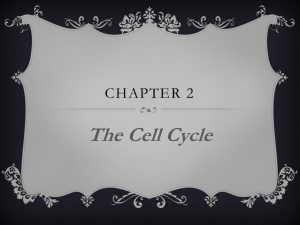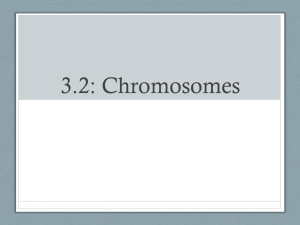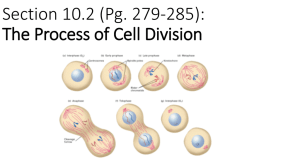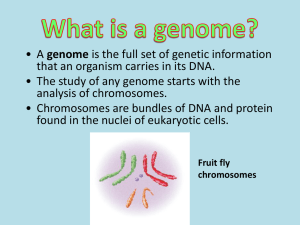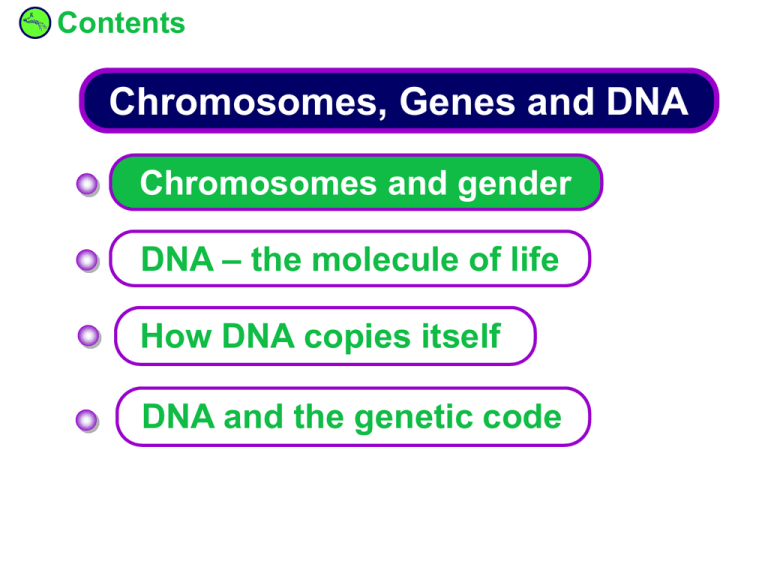
Contents
Chromosomes, Genes and DNA
Chromosomes and gender
DNA – the molecule of life
How DNA copies itself
DNA and the genetic code
What are little girls and boys made of?
Sugar and spice and everything nice;
that’s what little girls are made of.
Slugs and snails and puppy dogs’ tails;
that’s what little boys are made of.
What are little girls and boys really made of?
Inherited characteristics
What makes this baby human? What determines its gender?
In all living things, characteristics are passed on in the
chromosomes that offspring inherit from their parents.
So all human characteristics, including gender, must be
something to do with chromosomes.
Where are chromosomes found in cells?
What are chromosomes?
What are chromosomes?
Chromosomes are long strands of genetic information
located in the nuclei of cells.
Chromosomes are most visible
during cell division when they
replicate and look like this…
You will see chromosomes represented both ways.
Homologous chromosomes
In most cells chromosomes are matched in pairs based on
their size and shape.
chromosome from
female parent
chromosome from
male parent
homologous
chromosomes
Matching pairs of chromosomes are called homologous
chromosomes.
Where do homologous chromosomes come from?
Each pair of homologous chromosomes contains one
chromosome that has been inherited from each parent.
Homologous chromosomes
Human chromosomes
In human body cells there are a total
of 46 chromosomes.
How many pairs of homologous
chromosomes are there in
human body cells?
23 pairs of chromosomes
You inherit half your chromosomes from
your mother and half from your father.
How many chromosomes do you inherit from each parent?
23 unpaired chromosomes
Human chromosomes
X and Y chromosomes
There are two types of sex chromosome with names
that are very easy to remember!
X chromosome
Y chromosome
Females have two X chromosomes,
one from each parent.
XX
Males have one X chromosome
and one Y chromosome.
Which parent does a baby boy
inherit its Y chromosome from?
XY
X and Y chromosomes
Does this set of chromosomes come from a male or female?
1
2
3
4
5
6
7
8
9
10
11
12
13
14
15
16
17
18
21
19
22
20
23
XY
What kind of sex chromosomes are there in this person’s
sex cells?
Chromosomes and sex cells
What happens to the sex chromosomes when sex cells are
formed?
female
body cell
(XX)
meiosis
X
X
X
X
All ova have one X chromosome.
X
male
body cell
(XY)
X
Y
Y
meiosis
Sperm have an X or Y chromosome.
Why is there an equal chance of a baby being a boy or a girl?
Chromosomes, genes and gender quiz
Contents
Chromosomes, Genes and DNA
Chromosomes and gender
DNA – the molecule of life
How DNA copies itself
DNA and the genetic code
What are chromosomes made of?
Chromosomes carry the genetic information for making all
living things - everything from a human to a gerbil!
Why are chromosomes known as “instructions for life”?
What are these “instructions for life” made of?
What is DNA?
What is DNA?
Chromosomes and their genes are made of a molecule
called DNA.
DNA stands for
deoxyribosenucleic
acid.
Each chromosome
is a very long molecule
of tightly coiled DNA.
DNA molecules carry the code that controls what your cells
are made of and what they do.
Which part of a DNA molecule holds this information?
Structure of DNA
DNA and base pairs
The rungs of the DNA ladder are made from pairs of bases.
There are four types of bases. They have complicated
names so it is easier to use their initials instead.
These bases always pair together in the same way.
How do you think the four bases pair up?
DNA and base pairs
Base pairs hold the two strands of the DNA helix together.
The rules for base pairing are…
A always pairs with T
C always pairs with G
There are millions of base pairs in a DNA molecule that
always follow these rules.
Amazingly, it is the sequence of bases along a DNA
molecule that forms the genetic code - it’s that simple!
Build your own DNA molecule
Matching genetic pairs – numbers
Matching genetic pairs – sequences
DNA – true or false?
Contents
Chromosomes, Genes and DNA
Chromosomes and gender
DNA – the molecule of life
How DNA copies itself
DNA and the genetic code
DNA and cell division
What happens to the chromosomes when a cell divides
during mitosis?
cell
division
chromosomes
are copied
Why must chromosomes be copied before a cell divides?
What must happen to DNA during this same process?
DNA and cell division
A DNA molecule is able to make a copy of itself.
This is how chromosomes are copied before cell division.
DNA’s ability to copy itself means that all the genetic
information is passed on to new cells.
How does a DNA helix make a copy of itself?
How does DNA copy itself?
How DNA copies itself
DNA can make copies of itself because it is double stranded.
The DNA molecule “unzips” as the rungs of the ladder
separate and the molecule splits into two single strands.
How DNA copies itself
New bases from the cell move in and following the pairing
rules match themselves to the bases on the single strands.
new DNA molecules
Each single strand builds up into a new double strand.
What do you notice about the new DNA molecules?
How DNA copies itself
The new DNA molecules are identical to each other and
the original DNA molecule.
replication
original DNA molecule
new DNA molecules
What is the copying of DNA is also called?
Copying DNA and mutations
Sometimes mistakes are made
in the copying of DNA and the
sequences of bases is changed.
How does this affect the genetic
information carried by the DNA?
If the sequence of bases on the DNA molecule is changed by
mistake, the genetic information is also changed.
This type of change is called a mutation.
Why can mutations be harmful?
What’s the order?
© Boardworks Ltd 2004
DNA multiple choice
Contents
Chromosomes, Genes and DNA
Chromosomes and gender
DNA – the molecule of life
How DNA copies itself
DNA and the genetic code
Why are cells different?
An oak tree has about 30 different types of cells.
How many different types of cells are humans made of?
Our bodies have more than 300 different types of cells.
Why do cells have different characteristics?
Why are cells different?
Different types of cells produce different types of proteins.
Keratin is a protein in hair,
nails and some skin cells.
Outer shells of
insects contain
hardening
proteins.
Enzymes in plants
control photosynthesis.
Elastin and collagen are
other proteins in skin.
What are proteins made of?
What are proteins made of?
Proteins are long molecules made from chemical units
called amino acids.
protein
molecule
amino acid
What happens if amino acids are combined in a different
order?
Different combinations of amino acids make different proteins.
Connecting proteins and genes
Consider the following two statements…
Genes carry the
instructions for
inherited characteristics.
Cells have different
characteristics because
they make different
types of proteins.
What is the connection between genes and proteins?
Genes contain the instructions
for making proteins.
What molecule has the instructions for making proteins?
How do genes make proteins?
Genes are made of DNA. Proteins are made of amino acids.
Each amino acid is coded for by its own special sequence
of three bases called a triplet:
triplet
amino acid
How do genes make proteins?
The order of triplets in a gene determines the sequence
of amino acids.
The amino acids join together to form a protein molecule.
Each gene contains the sequence of bases for one protein.
Why is the sequence of bases in DNA called the genetic code?
How do the genes make proteins?
The genetic code is the order of DNA bases which
determines the sequence of amino acids in a protein.
How many triplets code for a protein of 20 amino acids?
1 amino acid = 1 triplet
20 amino acids = 20 triplets
How many bases code for a protein of 20 amino acids?
Build your own protein molecule
DNA mutations and proteins
A mutation is a change in the sequence of bases in DNA.
mutation
Mutations can be caused by mistakes in copying DNA
or the effects of radiation and heavy metal ions.
Will the mutated version of DNA make the same protein?
DNA mutations and proteins
A DNA mutation changes the amino acid sequence
and so a different protein may be produced.
If genes produce incorrect proteins, cells may not function
properly. This is the cause of many inherited diseases.
Genetic code quiz


